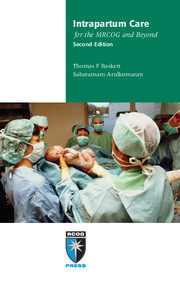Book contents
- Frontmatter
- Contents
- Preface
- Abbreviations
- 1 Improving intrapartum care
- 2 First stage of labour
- 3 Second stage of labour
- 4 Fetal surveillance in labour
- 5 Third stage of labour
- 6 Lower genital tract trauma
- 7 Induction of labour
- 8 Preterm labour and prelabour rupture of membranes
- 9 Assisted vaginal delivery
- 10 Shoulder dystocia
- 11 Breech vaginal delivery
- 12 Twin and triplet delivery
- 13 Caesarean section
- 14 Vaginal birth after caesarean section
- 15 Uterine rupture
- 16 Emergency obstetric hysterectomy
- 17 Cord prolapse
- 18 Antepartum haemorrhage
- 19 Postpartum haemorrhage
- 20 Acute uterine inversion
- 21 Amniotic fluid embolism
- 22 Disseminated intravascular coagulation
- 23 Acute tocolysis
- 24 Severe pre-eclampsia and eclampsia
- 25 Neonatal resuscitation
- 26 Perinatal loss: management of late fetal death and stillbirth
- Index
12 - Twin and triplet delivery
Published online by Cambridge University Press: 05 July 2014
- Frontmatter
- Contents
- Preface
- Abbreviations
- 1 Improving intrapartum care
- 2 First stage of labour
- 3 Second stage of labour
- 4 Fetal surveillance in labour
- 5 Third stage of labour
- 6 Lower genital tract trauma
- 7 Induction of labour
- 8 Preterm labour and prelabour rupture of membranes
- 9 Assisted vaginal delivery
- 10 Shoulder dystocia
- 11 Breech vaginal delivery
- 12 Twin and triplet delivery
- 13 Caesarean section
- 14 Vaginal birth after caesarean section
- 15 Uterine rupture
- 16 Emergency obstetric hysterectomy
- 17 Cord prolapse
- 18 Antepartum haemorrhage
- 19 Postpartum haemorrhage
- 20 Acute uterine inversion
- 21 Amniotic fluid embolism
- 22 Disseminated intravascular coagulation
- 23 Acute tocolysis
- 24 Severe pre-eclampsia and eclampsia
- 25 Neonatal resuscitation
- 26 Perinatal loss: management of late fetal death and stillbirth
- Index
Summary
Since the mid-1990s, as a result of assisted reproductive technology, the incidence of twin pregnancy has doubled and the number of triplets has increased ten-fold. Compared with singleton pregnancies, the perinatal morbidity and mortality of twins is increased five- to ten-fold and to a much greater degree for triplets and higher-order multiple births. Overall, multiple pregnancies account for about 3% of all births but contribute approximately 25% of early preterm births (less than 32 weeks of gestation), low-birthweight infants (under 2500 g), and very low-birthweight infants (under 1500 g). Compared with singletons, the incidence of cerebral palsy is increased eight-fold in twins and about 40-fold with triplets. The main determinants of this increase in morbidity and mortality are prematurity, growth restriction, anomalies and twin-to-twin transfusion. Asphyxia and trauma during delivery make a smaller contribution to morbidity and mortality but can be all the more tragic when the safe conclusion of a high-risk pregnancy is at hand. It is therefore understandable that in many developed countries the caesarean section rate for twins has roughly doubled, from 25% to 50%, since the mid-1990s, although there is no proof that abdominal delivery is safer for the infants. An international randomised trial is under way to determine the safest mode of delivery.
However, it is clear that, irrespective of the mode of delivery, twins should be delivered in hospitals with adequate anaesthetic, obstetric and neonatal personnel and facilities.
- Type
- Chapter
- Information
- Intrapartum Care for the MRCOG and Beyond , pp. 145 - 154Publisher: Cambridge University PressPrint publication year: 2011



